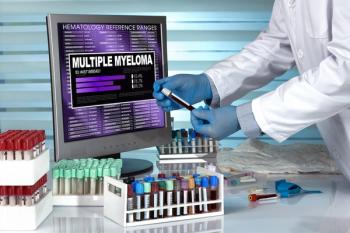
Early Data Show Divesiran Reduces Phlebotomy Needs in Polycythemia Vera: Marina Kremyanskaya, MD, PhD
Early results from the phase 1 SANRECO trial suggest that divesiran is safe and well tolerated, and may reduce the need for phlebotomy in patients with polycythemia vera by increasing hepcidin levels and improving iron regulation, according to lead investigator Marina Kremyanskaya, MD, PhD.
Marina Kremyanskaya, MD, PhD, associate professor of medicine at the Icahn School of Medicine at Mount Sinai and lead investigator of the ongoing phase 1/2 SANRECO trial (NCT05499013), explores research with The American Journal of Managed Care during an interview at the
The study investigates divesiran, a novel small interfering RNA therapy, in patients with polycythemia vera, a myeloproliferative neoplasm characterized by excessive red blood cell production and reflected by elevated hematocrit levels, which increase the risk of thromboembolic events.
Kremyanskaya explains that in the phase 1 trial, divesiran was safe and well tolerated, increased hepcidin levels, and reduced the need for phlebotomy, especially in patients with lower starting hematocrit levels. She shared these findings with attendees on Thursday during the presentation of her abstract, “SANRECO, an On-Going Phase 1/2 Study Evaluating Divesiran, A Novel Galnac-Conjugated Sirna, in Patients With Polycythemia Vera.”
This transcript was lightly edited; captions were auto-generated.
Transcript
For context, can you briefly explain how polycythemia vera is typically treated?
Polycythemia vera is a chronic myeloid malignancy. The biggest issue with polycythemia vera is that these patients are at high risk for thrombosis, as well as progression to myelofibrosis and acute leukemia.
Most of the treatments that we currently use, the goal of the treatment is to reduce the risk of thrombosis because that's the biggest cause of morbidity and mortality for these patients. Patients are often treated with low-dose aspirin, but the main goal of therapy is to maintain hematocrit at less than 45%, since polycythemia vera is marked by this very significant erythrocytosis, and that's what's been shown to be the most significant factor for thrombosis.
The goal [is for] hematocrit to be maintained at less than 45%, and this is done by using therapeutic phlebotomies. Basically, when patients get to a certain amount for hematocrit, we remove blood from them to keep that at [the] goal.
Typically, those [patients who] are considered to be at higher risk for thrombotic events are also treated with cytoreductive therapy in addition to phlebotomy, which could be hydroxyurea, probably the most commonly used drug in the world, as well as [the] JAK inhibitor ruxolitinib, or various formulations of interferon.
With that in mind, what was the primary objective of the ongoing phase 1/2 SANRECO trial? What methods did you use to investigate this?
The SANRECO trial is looking to see if this novel therapy, a drug called divesiran, which is a small interferon RNA against TMPRSS6, is safe and tolerated, but also if it's able to maintain patients phlebotomy free for those patients [who] do need high numbers of phlebotomies.
Can you summarize the key findings from the phase 1 portion of the trial? Were there any results that were particularly unexpected or encouraging?
The phase 1 study looked at 3 different dose cohorts for patients [who] were heavily phlebotomy dependent. Patients had to have at least 3 phlebotomies in the 6 months prior to enrollment, or 5 phlebotomies in 1 year prior to enrollment.
They were treated at 3 different drug levels, so cohort one, 3 mg, 6 mg, or 9 mg/kg, to see which dose is going to be most effective. The idea is to raise endogenous hepcidin levels so that [the] result in [the] restriction of iron that goes to the bone marrow available for erythropoiesis.
All those levels resulted in [an] increase in hepcidin levels, and all those levels resulted in decrease in hematocrit, decrease in hemoglobin, and significant decrease in the number of phlebotomies that these patients required. In fact, those patients that, at baseline when they started the study, had hematocrit that was less than 45%, so they were well controlled with phlebotomies prior to starting the study, they did not need any phlebotomies while on study. These are patients [who] needed anywhere from 2 to 9 phlebotomies in the 6-month period before the start of the study.
This drug is able to eliminate the need for phlebotomies in these patients, as well as increase the total ferritin levels in these patientd that indicates that the overall iron deficiency in the body is improving.
What additional research is needed to build on these findings? What are the next steps in clinical development for divesiran?
This was a phase 1 study with a relatively small number of patients. There were 21 patients enrolled in the study, so, of course, we need more patients, more data, and longer follow-up.
Currently, [the] phase 2 study is enrolling patients, and that's going to be a randomized study where 2 different dosing regimens of divesiran are being tested: one that's used every 6 weeks, the subcutaneous injection, that's going to be given every 6 weeks, or every 12 weeks, or a placebo group.
This will really allow us to get prospective results in [a] randomized fashion, as well as to be able to evaluate some of the patient-reported outcomes in terms of symptoms that these patients experience, which is always a very important aspect of these studies in [patients with] polycythemia vera.
Newsletter
Stay ahead of policy, cost, and value—subscribe to AJMC for expert insights at the intersection of clinical care and health economics.













































